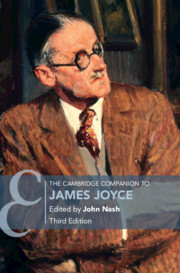
- Coming soon
- Publisher:
- Cambridge University Press
- Expected online publication date:
- August 2025
- Print publication year:
- 2025
- Online ISBN:
- 9781009636414

The Cambridge Companion to James Joyce is an indispensable scholarly guide to one of the world's most important and influential writers. Fifteen chapters, each written by a leading Joyce scholar, address each of Joyce's major works, key contexts and important themes. This is both an accessible introduction for students and a lively resource for teachers and researchers. This is a much revised and expanded third edition, featuring eleven entirely new essays and four revised essays. The editorial matter (chronology and guide to further reading) has been written from scratch. The third edition creates more space for Joyce's fascination with gender, sex and bodies, and provides renewed attention to his engagement with Irish history. Scholarship on ecocriticism, serialization, editing and publishing is also represented for the first time. Joyce's most influential work, Ulysses, has two dedicated chapters covering different aspects and perspectives, as well as an chapter on its serialization.
 Loading metrics...
Loading metrics...
* Views captured on Cambridge Core between #date#. This data will be updated every 24 hours.
Usage data cannot currently be displayed.
The PDF of this book is known to have missing or limited accessibility features. We may be reviewing its accessibility for future improvement, but final compliance is not yet assured and may be subject to legal exceptions. If you have any questions, please contact accessibility@cambridge.org.
Allows you to navigate directly to chapters, sections, or non‐text items through a linked table of contents, reducing the need for extensive scrolling.
Provides an interactive index, letting you go straight to where a term or subject appears in the text without manual searching.
You will encounter all content (including footnotes, captions, etc.) in a clear, sequential flow, making it easier to follow with assistive tools like screen readers.
You get more than just short alt text: you have comprehensive text equivalents, transcripts, captions, or audio descriptions for substantial non‐text content, which is especially helpful for complex visuals or multimedia.
You will still understand key ideas or prompts without relying solely on colour, which is especially helpful if you have colour vision deficiencies.
You benefit from high‐contrast text, which improves legibility if you have low vision or if you are reading in less‐than‐ideal lighting conditions.